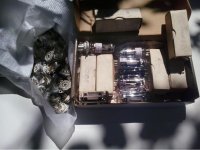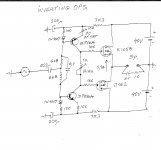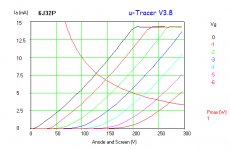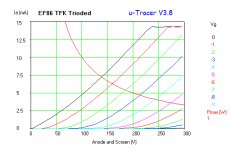Member
Joined 2009
Paid Member
Hi Banat, how do we deal with PSRR limitations of the common Source output - maybe not a problem at all?
Hi AJT - thanks for that - sounds like I should not worry about using older tubes.
that is because peanut tubes are almost always run at a fraction of their plate ratings, unlike power tubes...
Hi Banat, how do we deal with PSRR limitations of the common Source output - maybe not a problem at all?
Hi Bigun !
What about of using of well regulated SMPS unit for supplying common source OPS instead of ordinary transformer based PSU ?
Member
Joined 2009
Paid Member
I don't know much about SMPS - I assume you mean one which has effectively a regulated output voltage. This could be a good way if the supply is fairly quiet.
Bigun
Yes using quality SMPS is best & cheaper way to go with this type of OPS .
But what do you think about using of this high voltage gain tube front end in conjunction with some modest AC coupled phase inverting BJT OPS fully complementary Triple ? , supplied from conventional PSU with let`s say max. +/- 40VDC ? , since OPS triple configuration will have lowest loading effect on tube CF driver stage .
Any idea ?
Yes using quality SMPS is best & cheaper way to go with this type of OPS .
But what do you think about using of this high voltage gain tube front end in conjunction with some modest AC coupled phase inverting BJT OPS fully complementary Triple ? , supplied from conventional PSU with let`s say max. +/- 40VDC ? , since OPS triple configuration will have lowest loading effect on tube CF driver stage .
Any idea ?
Last edited:
Member
Joined 2009
Paid Member
Using a BJT triple EF is a completely different approach but is also an attractive option. It doesn't have gain though but should have better PSRR. You may not need a triple if you have a cathode follower, a double EF may be OK too. But it needs thermal control, at least with LatFETs if you have them running at 100mA or so you don't need careful thermal control of their bias. The BJT triple with Vbe multiplier is a more complex option. I don't know which would sound best though !
Bigun
There is many SS OPS options which can be incorporated on this hybrid Amp , Triple OPS is more complicated than simple common source lat.FET OPS for sure , but I think that Triple can be inherently more linear than proposed AB class lat. FET OPS , and inherently better sounding .
but I must point that Triple stage must have one Inverting stage due correct GNFB loop phase ,
I`m not sure which stage need to be Inverting one , but I`m sure that first stage closest to CF driver stage have to be EF , firstly because of lowest loading effect , maybe you have some answer ?,
actually mine opinion is that CF driver stage have to drive impedance of min . 50K , but ideally some infinite impedance .
( In the mid time I collect parts for one pair of full tube Futterman H1 OTL Amp .😀)
There is many SS OPS options which can be incorporated on this hybrid Amp , Triple OPS is more complicated than simple common source lat.FET OPS for sure , but I think that Triple can be inherently more linear than proposed AB class lat. FET OPS , and inherently better sounding .
but I must point that Triple stage must have one Inverting stage due correct GNFB loop phase ,
I`m not sure which stage need to be Inverting one , but I`m sure that first stage closest to CF driver stage have to be EF , firstly because of lowest loading effect , maybe you have some answer ?,
actually mine opinion is that CF driver stage have to drive impedance of min . 50K , but ideally some infinite impedance .
( In the mid time I collect parts for one pair of full tube Futterman H1 OTL Amp .😀)
Attachments
Last edited:
Member
Joined 2009
Paid Member
I've only ever made one amplifier with a triple OPS, that was TGM3 and I used a CFP-EF approach rather than triple EF. So I'm not really qualified to talk much about the the triple OPS.
However, I think the simpler circuit with LatFETs is the place to start since you have the parts to hand; maybe the whole thing can be made without a pcb. I see others having used LATFETS in all-SS designs with good results.
My TGM7 used common source FETs in the output and I like the sound - they were Vertical FETs mind and it had a fairly high feedback factor.
However, I think the simpler circuit with LatFETs is the place to start since you have the parts to hand; maybe the whole thing can be made without a pcb. I see others having used LATFETS in all-SS designs with good results.
My TGM7 used common source FETs in the output and I like the sound - they were Vertical FETs mind and it had a fairly high feedback factor.
Bigun
Will check both of your TGM3 & TGM7 Amps on SS forum department for sure !
And of course that I don`t plan to use pcb for this small hybrid amp , everything must be connected using only point to point technique .
About LatFet`s you are right , if they are implemented in proper way than they work very stable and sounds pretty good .
BTW , I`m consider this relative simple inverting OPS too , driven from CF part of tube stage , it consist from pair of LatFet`s in common drain configuration driven from two modulated PP - CCS , those two CCS are OPS bias generator in the same time .
As I say earlier there is so much possibility for implementation of different OPS types , need time to experiment and to found best solution , which usually is the simplest one .
Will check both of your TGM3 & TGM7 Amps on SS forum department for sure !
And of course that I don`t plan to use pcb for this small hybrid amp , everything must be connected using only point to point technique .
About LatFet`s you are right , if they are implemented in proper way than they work very stable and sounds pretty good .
BTW , I`m consider this relative simple inverting OPS too , driven from CF part of tube stage , it consist from pair of LatFet`s in common drain configuration driven from two modulated PP - CCS , those two CCS are OPS bias generator in the same time .
As I say earlier there is so much possibility for implementation of different OPS types , need time to experiment and to found best solution , which usually is the simplest one .
Attachments
Last edited:
Member
Joined 2009
Paid Member
This looks like it can offer much better PSRR than your first design, but those 3R3 rail resistors want to be larger so that in combination with the 220uF rail caps you get a low enough corner frequency to keep power rail noise (and signal return currents) away from the bipolar devices.
You have the tube stage feeding the centre of two resistors - not sure why you want to do that. Why not have two coupling capacitors directly to the bases of the transistors, similar to your original design ?
Not familiar with these exact FETs - probably want to allow space for external gate protection zener diodes.
Do you need the dc-offset adjust pot / 100R resistors in the emitters of the drivers - unless you plan is to degenerate the gain of these devices you might have the emitters sit at the power rails and adjust dc-offset in the supply to the transistor bases ?
You have the tube stage feeding the centre of two resistors - not sure why you want to do that. Why not have two coupling capacitors directly to the bases of the transistors, similar to your original design ?
Not familiar with these exact FETs - probably want to allow space for external gate protection zener diodes.
Do you need the dc-offset adjust pot / 100R resistors in the emitters of the drivers - unless you plan is to degenerate the gain of these devices you might have the emitters sit at the power rails and adjust dc-offset in the supply to the transistor bases ?
Last edited:
Bigun
Yes this type of OPS have much better PSRR than my previous proposed OPS and allow use of conventional PSU ,
basically those two 3R3 an two 220uF can be omitted from schematic without to significantly compromise OPS PSSR factor ,
we can use two coupling cap , each one attached on top and bottom driver Tr. bases , but I think that this proposed `one coupling cap ` solution is also good , since with triming mutual values between of those two res .we can set output AC balance to get desired distributed output THD spectrum .
those Hitachi / Renesas LatFet`s already have build in protection zener diodes and also protection flyback diode between drain and source , so no need for external extra protection .
I will leave those two 100R degenerative res .on place .
It is interesting that this OPS can be driven from just one high gain triode , where Russian 6C45PI is very good choice , but from Futterman high gain tube input stage too .
Yes this type of OPS have much better PSRR than my previous proposed OPS and allow use of conventional PSU ,
basically those two 3R3 an two 220uF can be omitted from schematic without to significantly compromise OPS PSSR factor ,
we can use two coupling cap , each one attached on top and bottom driver Tr. bases , but I think that this proposed `one coupling cap ` solution is also good , since with triming mutual values between of those two res .we can set output AC balance to get desired distributed output THD spectrum .
those Hitachi / Renesas LatFet`s already have build in protection zener diodes and also protection flyback diode between drain and source , so no need for external extra protection .
I will leave those two 100R degenerative res .on place .
It is interesting that this OPS can be driven from just one high gain triode , where Russian 6C45PI is very good choice , but from Futterman high gain tube input stage too .
And are they any good (linearity-wise as voltage amplifiers) ? 🙂
Here are a couple of traces I did to compare the 6J32P with a Telefunken EF86 when triode connected:
The current limiting set can be seen in the rolloff at the top of the traces.
Attachments
Member
Joined 2009
Paid Member
Thanks Rotaspec - from an quick 'eye ball' they both look similar and both look fairly linear. It seems that for around 5mA 1W the russian tube allows a lower plate voltage for the same grid bias - not sure what I'd pick here but I like the idea of good headroom so looks like 175V on the russian tube.
Since you have both tubes, did you build anything before that allows you to compare them sound-wise ?
Since you have both tubes, did you build anything before that allows you to compare them sound-wise ?
- Status
- Not open for further replies.
- Home
- Amplifiers
- Tubes / Valves
- is 6J32P equivalent of EF806 ?



